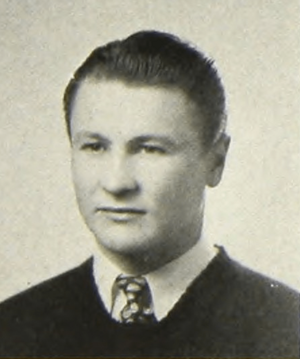Bill Daley (American football) facts for kids

Daley pictured c. 1942 at the University of Minnesota
|
|||||||
| No. 71, 77, 73 | |||||||
|---|---|---|---|---|---|---|---|
| Position: | Fullback, defensive back, linebacker | ||||||
| Personal information | |||||||
| Born: | September 16, 1919 Melrose, Minnesota, U.S. |
||||||
| Died: | October 19, 2015 (aged 96) Edina, Minnesota, U.S. |
||||||
| Career information | |||||||
| College: | Minnesota, Michigan | ||||||
| NFL Draft: | 1943 / Round: 1 / Pick: 7 (By the Steagles) |
||||||
| Career history | |||||||
|
|||||||
| Career highlights and awards | |||||||
|
|||||||
| Career NFL statistics | |||||||
|
|||||||
| Player stats at PFR | |||||||
William Edward Daley (born September 16, 1919 – died October 19, 2015) was a famous American football player. He was an All-American fullback.
Daley played college football for the University of Minnesota Golden Gophers from 1940 to 1942. His team won national championships in 1940 and 1941. In 1943, he played for the University of Michigan Wolverines. He was named a unanimous All-American that year. He also finished sixth in the Heisman Trophy voting.
Bill Daley has a special record. He is the only player to win the Little Brown Jug game for both Minnesota and Michigan. He won all four of these games he played in.
After serving in World War II, Daley played professional football for three years. He played in the All-America Football Conference (AAFC). Later, he became a radio announcer for college and professional football teams. He also owned an art gallery.
Contents
Early Life and Football Start
Bill Daley was born and grew up in Melrose, Minnesota. After high school, he moved to Chicago, Illinois. He wanted to become a boxer.
Daley went to DePaul University in Chicago. There, a track and field coach saw his athletic talent. The coach convinced him to try football instead of boxing.
Playing for Minnesota
Daley joined the University of Minnesota football team. He played there from 1940 to 1942. The Gophers were very strong during these years.
They won two national championships. These wins happened in 1940 and 1941. In 1942, they almost won a third championship.
The Gophers also beat their rival, Michigan, in the Little Brown Jug game every year Daley played. In 1940, Minnesota won a close game against Michigan, 7–6.
Playing for Michigan
After the 1942 season, Daley joined the United States Navy. Because he was a college student, he was sent to a special Navy program. This program was at the University of Michigan.
Daley was only in Ann Arbor for six months. While there, Navy recruits had to stay in shape. They could join Navy fitness classes or practice with the Michigan football team. Michigan's coach, Fritz Crisler, asked Daley to play for his team. Daley still had one year of college eligibility left.
Daley's Impact at Michigan
Daley played for Michigan in 1943. He was one of the best rushers in the country, even though he played only six games. His speed and power helped Michigan tie for the Big Ten Conference title.
He ran for 817 yards and scored nine touchdowns. He also kicked three extra points. In total, he scored 57 points for the team. His best game was against Northwestern. He gained 216 yards and scored two touchdowns in that game.
The Little Brown Jug Record
In his last college game, Daley helped Michigan win the Little Brown Jug. This was the same trophy he had helped Minnesota win for three years. He is the only player ever to win this trophy playing for both teams.
Daley said winning the Little Brown Jug was very important. He was happy to have a 4–0 record in those games. Playing against his old Minnesota teammates was strange. But he was motivated to win the Jug for Michigan. Michigan won that game 49–6.
All-American Recognition
Daley was named an All-American by the Associated Press. This means he was one of the best college football players in the country. Reporters called him "Minnesota's gift to Michigan by way of the Navy."
Daley was very fast, able to run 100 yards in 10 seconds. Even though he played only six games, he gained 817 yards. He was then moved by the Navy to another location.
Daley felt lucky to play for two great schools. He said playing at Michigan was one of his greatest thrills. He was also proud to be in the Hall of Fames for both programs. His only regret was never beating Notre Dame.
Military Service During WWII
After his time at Michigan, Daley went to Columbia University. He was a leader in the Naval unit there.
He then went to a midshipman school in Portsmouth, Virginia. After that, he trained in Florida. He was on his way to the Pacific Ocean for the war. But World War II ended in August 1945. He stayed overseas for a while. He even played in an Army-Navy football game in Shanghai, China.
Professional Football Career
The Pittsburgh Steelers picked Bill Daley in the 1943 NFL Draft. He was the seventh player chosen overall. However, he never played for them.
After the war, Daley signed a contract to play professional football. He joined the new All-America Football Conference. He played for four teams over four seasons. These teams included the Brooklyn Dodgers, Miami Seahawks, Chicago Rockets, and New York Yankees.
Daley said players did not earn much money back then. They played mostly "for the love of the game." He enjoyed his college football days more than professional ones. His best pro season was in 1947 with the Chicago Rockets. He gained 633 total yards that year.
Life After Football
After his football career, Daley went back to the University of Minnesota. He earned a degree in education.
Broadcasting Career
He then became a radio announcer for ten years. He called games for the Minnesota Golden Gophers. He also did color commentary for the Minnesota Vikings when they first started in the early 1960s.
Daley Illustration Gallery
Bill Daley loved art, even though he said he couldn't paint or draw well himself. He became an art collector. In the early 1970s, he and his wife, Melba, opened an art studio.
Around 1974, they opened the Daley Illustration Art Gallery. It was located in the Hyatt Regency Hotel in downtown Minneapolis, Minnesota. Daley owned and ran this gallery until he passed away. The gallery has over 500 original illustrations. It is one of the best collections of its kind in the world.
Later Life and Legacy
Bill Daley married his wife, Melba, in 1972. He passed away on October 19, 2015, at the age of 96.
In 1983, a book called "A Century of All Americans" named Daley one of the All-Time Football Fullbacks. In 2005, he was chosen as one of the 100 greatest Michigan football players ever. He ranked 63rd on that list.
See also
- List of Michigan Wolverines football All-Americans


